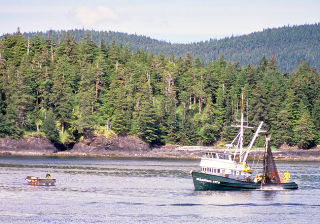The canned salmon of today is a vastly improved from product what it was 25 years ago. Now most boats in Alaska feature chilled circulating sea water fish holds. The salmon are taken from the cold, pristine waters of Alaska and put directly into these tanks, where they remain until they get to the processing plant, just hours later. The condition of today’s salmon is light years better than the good old days when the salmon were packed into unrefrigerated fish holds. No fisherman would eat canned salmon back then, but that is not true anymore.
I liken a can of traditional pack Redhead or Thinkpink, as a ‘Salmon steak in a can, perfectly poached (but really pressure cooked in the can), hours after capture, ready to be used in a host of dishes.’
We, the Zuanich family, commercially fish-from Dungeness crab to halibut and black cod as well as salmon. I feel privileged, no, blessed to have access to the seafood that I do, and we eat more canned salmon than any other fish. We have found canned salmon to be the absolute superior lunch time food. Hence, my most useful recipe card is probably, ‘Straight Out of the Can.’ Four or five times a week we eat salmon at lunch. I like my canned salmon with a half a toasted bagel or that wonderful German whole grain rye bread (Mestemacher is the brand), toasted, with a thin layer of lower fat cream cheese, salmon, a squeeze of lemon juice, some chopped red onion and maybe a few capers. If you accept my ‘perfectly poached salmon steak in a can’ routine, a can of salmon is just like having perfectly cooked salmon leftovers always at your beck and call.
We have quite an array of canned salmon recipes on our website, www.purealaskasalmon.com. The most surprising recipe, the one I often use in in store demonstrations, is “Fabulous Salmon Curry Salad.” It was a recipe I have used with chicken breast, but I just substituted canned salmon which is much easier, less costly and vastly more nutritious than your standard chicken breast. Due to technical malfunctions, I cannot attach that recipe here, but if you go to our website (purealaskasalmon.com), you can easily see it, and download a recipe card. It is canned salmon with apples, almonds, curry, raisins, etc, and it is sublime.
Redhead, the sockeye salmon is, well, red. It’s less expensive cousin, Thinkpink, looks just like tuna. It is easy to present Redhead as salmon, and it just sits on that bagel like that is where it belongs. I have demonstrated canned salmon to literally thousands and thousands of people, and they will generally claim that Redhead tastes better. That visual clue of the red flesh is just too powerful. However when tasted blindly, people cannot tell the difference, and nutritionally, both are about the same. The pink salmon can be used just like one would normally make a tuna salad, and one would be hard pressed to tell that it wasn’t a very good can of tuna. My husband uses the juice of the Redhead (there is no added oil or water, and any liquid comes solely from the salmon itself), but generally gives the less colorful pink salmon juice to the lucky cat or we freeze it to use in chowders. However, in the drained pink salmon, he adds a touch of olive oil and a little Dijon– very, very tasty.
Canned salmon is also a great protein for dinner time meals. We take canned salmon, I kid you not, on our commercial salmon fishing boat in the summer because it is so easy to make salmon cakes at night. As you can use every bit of the salmon in the can, including the digestible, soft bones and the omega 3 rich skin and fatty layer, using canned salmon is way less labor intensive than cooking up a fillet. Believe me, we cook plenty of the fillets, but making salmon cakes out of canned salmon after a long day is very delicious and easy route to an excellent supper. We like to spice them up with lots of curry or lemon or ginger. I have recipes, but just as often it is a spontaneous recipe based upon the most accessible spices in my cabinet.
I can literally, embarrassingly, rap on and on about canned Alaska salmon. It is a an amazing food nutritionally. It is pure, with no or negligible contaminants of any kind and it comes from a U.S. resource that has been extremely well managed. Alaska is considered to be perhaps the finest fisheries managers in the world.
Canned salmon, I also like to think, is democratic, because it is reasonably priced and can be found all over this country. I get a special thrill when I send a box of my salmon to South Dakota or to soldiers at APO addresses. Wild salmon, being rich in long chain omega 3 fatty acids also provide nutrients that Americans are generally very deficient in.









